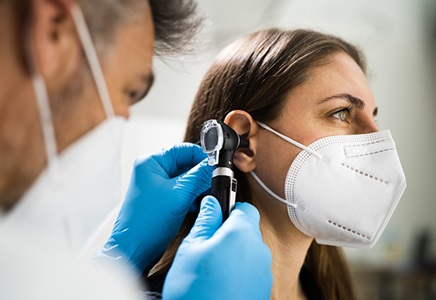Eustachian Tube Dysfunction
Featured Experts:
Overview
The Eustachian tube is an opening that connects the middle ear with the nasal-sinus cavity. This tube helps to:
- Balance pressure in the middle ear (commonly felt as your ears popping)
- Drain fluid from the middle ear
- Protect the ear from both hearing sounds your body causes and nasal drainage
This tube contains a valve that opens and closes. Inadequate opening of this tube can cause a buildup of fluid in the ears, which can lead to a feeling of pain and pressure in the ear. A tube that is too open can also cause a persistent feeling of pressure as well as hearing unusual sounds such as your own breathing or your own voice too loudly. Eustachian tube disorders are common and one of the leading causes of ear infections (otitis media).
Common Eustachian tube disorders include:
- Patulous Eustachian tube dysfunction
- Obstructive Eustachian tube dysfunction
- Baro-challenge-induced Eustachian tube dysfunction (obstructive Eustachian tube dysfunction when on airplanes or when SCUBA diving)
Eustachian Tube Dysfunction | FAQ
Patulous Eustachian Tube Dysfunction
Patulous Eustachian tube dysfunction is a disorder of the valve of the Eustachian tube that causes it to remain open. When this valve remains open, sound can travel from the nasal-sinus cavity to the ears, allowing you to hear your own voice or your own breathing too loudly, or even the sound of blood pumping. Patulous Eustachian tube dysfunction can also alternate with obstructive Eustachian tube dysfunction.
Symptoms of Patulous Eustachian Tube Dysfunction
Symptoms of patulous Eustachian tube dysfunction include:
- A sense of fullness in the ears
- The ability to hear your own voice, breathing or bodily functions very loudly
Causes of Patulous Eustachian Tube Dysfunction
Causes of patulous Eustachian tube dysfunction include:
- Weight loss
- Chronic neuromuscular or immunological disease
- Chronic nasal allergy
- A history of acid reflux disease
- Stress and anxiety
Diagnosing Patulous Eustachian Tube Dysfunction
Your doctor may use a variety of techniques to diagnose patulous Eustachian tube dysfunction while viewing your ear drum (tympanic membrane). Your doctor may ask you to breathe deeply and swallow to see how the ear drum responds. Your doctor may also measure the pressure inside your ear using specialized tools.
Treatment for Patulous Eustachian Tube Dysfunction
Medical treatment for patulous Eustachian tube dysfunction includes:
- Limiting decongestants and caffeine
- Drinking more water
- Medicated nasal drops
Surgery for patulous Eustachian tube dysfunction includes:
- Implants
- Fillers
- Grafts or fat transfers
The surgical method will be determined by your doctor. In some cases, tympanostomy tubes (ear tubes) may make the condition worse. Implants, fillers, grafts and fat transfers act to fill out the tissue in the surrounding area so the Eustachian tube can close properly and return to normal function. Sometimes grafts are applied to the ear drum.
Eustachian Tube Dysfunction
Obstructive Eustachian Tube Dysfunction
Obstructive dysfunction occurs when the valve of the Eustachian tube does not open properly. This prevents pressure from balancing and fluids from draining out of the ear.
Symptoms of Obstructive Eustachian Tube Dysfunction
Symptoms of obstructive Eustachian tube dysfunction include:
- Pressure and/or pain in the ears
- A sense of fullness in the ears
- Muffled hearing
Causes of Obstructive Eustachian Tube Dysfunction
Causes of obstructive Eustachian tube dysfunction include:
- Environmental allergies
- Sinusitis
- Acid reflux
- Neoplasms (abnormal growth of tissue)
- Impaired muscle coordination or muscular deficiency, for example, in patients with a cleft palate
Diagnosing Obstructive Eustachian Tube Dysfunction
Over time, negative pressure can build up in the ear, causing pain, ear fullness and muffled hearing. When this occurs, sometimes your doctor can see the ear drum (tympanic membrane) change shape due to this pressure and become concave. Negative pressure and structural changes in the ear can also be signs of obstructive Eustachian type dysfunction.
Obstructive eustachian tube dysfunction can be chronic, intermittent or short term. This is commonly felt during flights, when you have a cold or when SCUBA diving.
Baro-Challenge-Induced Eustachian Tube Dysfunction
When obstructive Eustachian tube dysfunction is only felt during airplane flights or SCUBA diving, this is known as baro-challenge-induced Eustachian tube dysfunction.
Treatment for Obstructive Eustachian Tube Dysfunction
Following evaluation and diagnosis, your doctor will determine the best course of treatment. This may include medication or surgery, and a doctor may recommend avoiding triggers. Surgical treatments include:
- Tympanostomy tubes (ear tubes)
- Balloon dilation of the eustachian tube
- Adenoidectomy (removal of adenoids in the back of the nose)
- Potassium titanyl phosphate (KTP) laser to reduce inflamed tissue
Common Misconceptions About Eustachian Tube Dysfunction
A common course of treatment for Eustachian tube dysfunction is the use of decongestants or antihistamines. In some cases, this treatment may make the condition worse. If decongestants or antihistamines do not provide relief, contact your doctor. You may need to see an ear, nose and throat specialist for treatment.
Johns Hopkins Eustachian Tube Health Center

The Johns Hopkins Eustachian Tube Health Center provides comprehensive evaluation, diagnosis and management of Eustachian tube dysfunction that include medical, multidisciplinary and surgical approaches.










